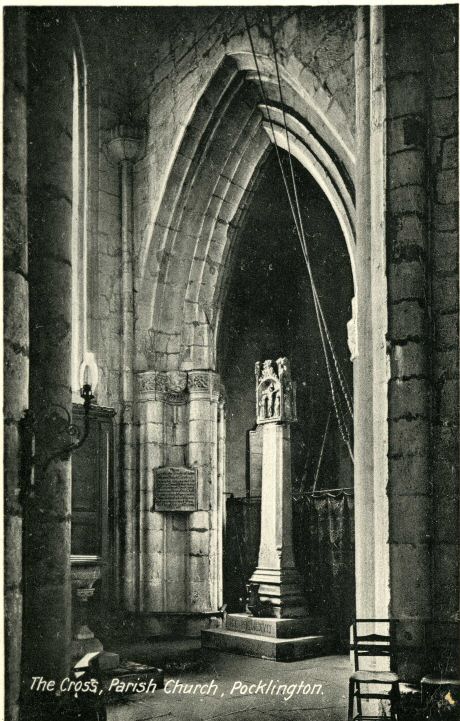|
THE SOTEBY CROSS.
TO THE EDITOR of THE "WEEKLY NEWS"
Sir.
At The Church Bazaar recently held in the Grammar School grounds, were exhibited for sale photographic pictures of a very interesting relic, known as Soteby's cross. On the assumption that some of the photos may have been purchased by individuals who are unacquainted with the history of the cross, I will subjoin a few particulars which I have been able to collect. The cross is now erected on a pedestal at the north side of the west end of the nave of the church. On one of the pillars opposite is a stone tablet bearing the following inscription.
"The Churchyard Cross. Erected about the middle of the fifteenth century to the memory of John Soteby, was discovered in A.D. 1835, when digging a grave near the west door of the Church, where during the civil wars it had no doubt been deposited for preservation. It was restored and retracted A.D. 1855 (with the permission of the Rev. J. F Ellis, Vicar of Pocklington, and Church wardens), in the Churchyard at the expense of Samuel Leigh Soteby, of the Woodlands, Norwood in the county of Surrey, he being a descendant of the elder branch of the Soteby family."
There is some doubt as to the correctness of the date assigned to this remarkable monument by the Tablet; many architects consider it to be at least a century older. It will be observed from the photograph that on this ancient stone is sculptured on one side the crucifixion, and though not discernable, a Latin inscription, " Pray for the soul of John Soteby." An inscription also in Latin at the foot of the cross. " Hic Pavlinus Celebravt et Predicavit A.D. 627." translated "Here Paulinus celebrated (the Holy Communion) and preached A.D. 627." points to a remarkable and deeply absorbing period of Church history as connected with Pocklington. At the same time as the Soteby cross was found, a much mutilated stone near to it was unearthed, on which was chiseled the above inscription ; the date carrying us back twelve hundred and sixty-five years. This pediment stone contained a socket into which the shaft of the old Cross had evidently fitted. And in the opinion of the late learned Dr. Wilson who was an archaologist of considerable reputation, it originally stood on the site ot the first churchyard Cross, (which the present cross replaced), on the steps of which Paulinus preached with such conspicuous success to the natives of this neighbourhood who were Saxon Idolaters. Paulinus was consecrated that same year the first Archbishop of York. We are left to conjecture what kind of a church was first erected here, probably a partially wooden structure; but there is no reason why the time should not lie coupled with the recorded tradition of baptisms having been celebrated in the waters of our Beck which flow through the churchyard, or in the Holy well on Chapel Hill.
At the risk of what is perhaps well-known in the district, I submit the following statement, forgetting for the moment from what source I obtained it. "Goodmanham is a village near Market Weighton, which it associated with the first appearance of Christianity in these islands, the Church having been built on the site of the Pagan Temple, which was under the official care of Coifi, high priest of Oden. Convinced however by the arguments of the missionary Paulinus, he broke in pieces the idol, and was baptized in company with king Edwin, while the Saxon temple was replaced by a Christian Church."
The conversion ot this heathen arch-priest Coifi, look place at a conference held in this immediate neighbourhood, of which the famous Church historian, the venerable Bede, gives a most interesting account. Unfortunately he does not mention the place of the meeting. Three places contend for the honour, Pocklington, Aldby, and Londesborough.
Dr. Wilson strenuously maintained that Pocklington was the site ot the assembly, when the King, his nobles and the leaders of the old religion, agreed to abandon idolatry and adopt the Christian faith. The arguments he was fond of adducing in favour of Pocklington were these, Aldby is too far off from Goodmanham for a horse to gallop between the places. Bede mentions that Coifi did so on one of the King's white steeds. There is no stream at Londesborough, to which incidental mention is made in Bede's history, neither was it in those days a Royal Domain, whereas Pocklington was from earliest times a Royal Manor, and continued so for hundreds of years, it has also a considerable tributary of the river Derwent flowing through it,
and moreover it is within an easy ride of Goodmanham. At all events there can be little doubt that Pocklington was visited by the Missionary and a stone commemorative of the event erected.
So great a curiosity is our Churchyard Cross considered by the Royal Society of Antiquarians, that they ordered a plaster cast to be taken of it, which they have deposited in the Court of Medieval Art in the Crystal Palace.
Solemn and touching are the echoes of time that carry our thoughts back to so remote and a dim past, overshadowed by a long antiquity.
J.S.
Pocklington, Sept. 22nd. 1892.
P.S.—I understand the Vicar has a few photographs of the Cross left for sale, for the benefit of the Restoration Fund. One shilling each.

This, I believe, is the photo mentioned in the letter above.
|

